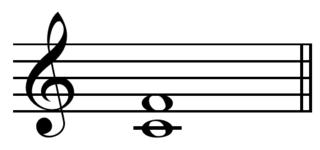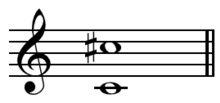In music theory, the minor scale is three scale patterns – the natural minor scale, the harmonic minor scale, and the melodic minor scale – rather than just two as with the major scale, which also has a harmonic form but lacks a melodic form.
In music theory, an interval is a difference in pitch between two sounds. An interval may be described as horizontal, linear, or melodic if it refers to successively sounding tones, such as two adjacent pitches in a melody, and vertical or harmonic if it pertains to simultaneously sounding tones, such as in a chord.
In music theory, the tritone is defined as a musical interval composed of three adjacent whole tones. For instance, the interval from F up to the B above it is a tritone as it can be decomposed into the three adjacent whole tones F–G, G–A, and A–B.
Articles related to music include:
In music, a whole-tone scale is a scale in which each note is separated from its neighbors by the interval of a whole tone. In twelve-tone equal temperament, there are only two complementary whole-tone scales, both six-note or hexatonic scales. A single whole-tone scale can also be thought of as a "six-tone equal temperament".

A fourth is a musical interval encompassing four staff positions in the music notation of Western culture, and a perfect fourth is the fourth spanning five semitones. For example, the ascending interval from C to the next F is a perfect fourth, because the note F is the fifth semitone above C, and there are four staff positions between C and F. Diminished and augmented fourths span the same number of staff positions, but consist of a different number of semitones.

In music theory, a perfect fifth is the musical interval corresponding to a pair of pitches with a frequency ratio of 3:2, or very nearly so.

A chord, in music, is any harmonic set of pitches/frequencies consisting of multiple notes that are heard as if sounding simultaneously. For many practical and theoretical purposes, arpeggios and broken chords, or sequences of chord tones, may also be considered as chords in the right musical context.

A semitone, also called a half step or a half tone, is the smallest musical interval commonly used in Western tonal music, and it is considered the most dissonant when sounded harmonically. It is defined as the interval between two adjacent notes in a 12-tone scale. For example, C is adjacent to C♯; the interval between them is a semitone.

In Western music and music theory, diminution has four distinct meanings. Diminution may be a form of embellishment in which a long note is divided into a series of shorter, usually melodic, values. Diminution may also be the compositional device where a melody, theme or motif is presented in shorter note-values than were previously used. Diminution is also the term for the proportional shortening of the value of individual note-shapes in mensural notation, either by coloration or by a sign of proportion. A minor or perfect interval that is narrowed by a chromatic semitone is a diminished interval, and the process may be referred to as diminution.

In classical music from Western culture, an augmented fifth is an interval produced by widening a perfect fifth by a chromatic semitone. For instance, the interval from C to G is a perfect fifth, seven semitones wide, and both the intervals from C♭ to G, and from C to G♯ are augmented fifths, spanning eight semitones. Being augmented, it is considered a dissonant interval.
In music theory, an augmented sixth chord contains the interval of an augmented sixth, usually above its bass tone. This chord has its origins in the Renaissance, was further developed in the Baroque, and became a distinctive part of the musical style of the Classical and Romantic periods.
In music, a triad is a set of three notes that can be stacked vertically in thirds. Triads are the most common chords in Western music.
Chromaticism is a compositional technique interspersing the primary diatonic pitches and chords with other pitches of the chromatic scale. Chromaticism is in contrast or addition to tonality or diatonicism and modality. Chromatic elements are considered, "elaborations of or substitutions for diatonic scale members".
Not only at the beginning of a composition but also in the midst of it, each scale-step [degree] manifests an irresistible urge to attain the value of the tonic for itself as that of the strongest scale-step. If the composer yields to this urge of the scale-step within the diatonic system of which this scale-step forms part, I call this process tonicalization and the phenomenon itself chromatic.
Chromaticism is almost by definition an alteration of, an interpolation in or deviation from this basic diatonic organization.
Throughout the nineteenth century, composers felt free to alter any or all chord members of a given tertian structure [chord built from thirds] according to their compositional needs and dictates. Pronounced or continuous chordal alteration [and 'extension'] resulted in chromaticism. Chromaticism, together with frequent modulations and an abundance of non-harmonicism [non-chord tones], initially effected an expansion of the tertian system; the overuse of the procedures late in the century forewarned the decline and near collapse [atonality] of the system [tonality].
Chromaticism is the name given to the use of tones outside the major or minor scales. Chromatic tones began to appear in music long before the common-practice period, and by the beginning of that period were an important part of its melodic and harmonic resources. Chromatic tones arise in music partly from inflection [alteration] of scale degrees in the major and minor modes, partly from secondary dominant harmony, from a special vocabulary of altered chords, and from certain nonharmonic tones... Notes outside the scale do not necessarily affect the tonality...tonality is established by the progression of roots and the tonal functions of the chords, even though the details of the music may contain all the tones of the chromatic scale.
Sometimes...a melody based on a regular diatonic scale is laced with many accidentals, and although all 12 tones of the chromatic scale may appear, the tonal characteristics of the diatonic scale are maintained. ... Chromaticism [is t]he introduction of some pitches of the chromatic scale into music that is basically diatonic in orientation, or music that is based on the chromatic scale instead of the diatonic scales.
In Classical music theory, a Neapolitan chord is a major chord built on the lowered (flatted) second (supertonic) scale degree. In Schenkerian analysis, it is known as a Phrygian II, since in minor scales the chord is built on the notes of the corresponding Phrygian mode.
The Locrian mode is the seventh mode of the major scale. It is either a musical mode or simply a diatonic scale. On the piano, it is the scale that starts with B and only uses the white keys from there. Its ascending form consists of the key note, then: half step, whole step, whole step, half step, whole step, whole step, whole step.

In classical music from Western culture, an augmented sixth is an interval produced by widening a major sixth by a chromatic semitone. For instance, the interval from C to A is a major sixth, nine semitones wide, and both the intervals from C♭ to A, and from C to A♯ are augmented sixths, spanning ten semitones. Being augmented, it is considered a dissonant interval.

Diatonic and chromatic are terms in music theory that are most often used to characterize scales, and are also applied to musical instruments, intervals, chords, notes, musical styles, and kinds of harmony. They are very often used as a pair, especially when applied to contrasting features of the common practice music of the period 1600–1900.
In music theory, an inversion is a type of change to intervals, chords, voices, and melodies. In each of these cases, "inversion" has a distinct but related meaning. The concept of inversion also plays an important role in musical set theory.























